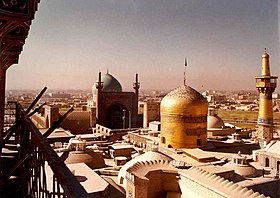Khorasan province
Khorasan Province
استان خراسان Khurasan Khorassan | |
|---|---|
Former province of Iran | |
 Location of Khorasan within Iran (pre-2004) | |
| Country | Iran |
| Dissolved | September 2004 |
| Area | |
| • Total | 299,231 km2 (115,534 sq mi) |
| Time zone | UTC+03:30 (IRST) |
| • Summer (DST) | UTC+04:30 (IRST) |
| Main language(s) | Persian |

Khorasan (Persian: استان خراسان [xoɾɒːˈsɒːn] ; also transcribed as Khurasan, Xorasan and Khorassan), also called Traxiane during Hellenistic and Parthian times, was a province in northeastern Iran until September 2004, when it was divided into three new provinces: North Khorasan, South Khorasan, and Razavi Khorasan.
Khorasan historically referred to a much larger area, comprising the east and the northeast of the Persian Empire. The name Khorāsān is Persian and means "where the sun arrives from".[1] The name was first given to the eastern province of Persia during the Sasanian Empire[2] and was used from the Late Middle Ages in distinction to neighbouring Transoxiana.[3][4][5]
This province, whose people are mainly Shia Muslims,[6] roughly encompassed the western portion of the historical Greater Khorasan.[7] The modern boundaries of the Iranian province of Khorasan were formally defined in the late nineteenth century[2] and the province was divided into three separate administrative divisions in 2004.[8]
History
[edit]The name Khorāsān (lit. "sunrise"; "east"; or "land of the rising sun") was originally given to the eastern province of Persia during the Sassanian period.[2] The old Iranian province of Khorasan roughly formed the western half of the historical Greater Khorasan,[7] a region which included parts that are today in Iran, Afghanistan, Tajikistan, Turkmenistan and Uzbekistan. Some of the main historical cities of Persia are located in the older Khorasan: Nishapur and Tus (now in Iran); Merv and Sanjan (now in Turkmenistan); Samarkand and Bukhara (both now in Uzbekistan); Herat and Balkh (now in Afghanistan); and Khujand and Panjakent (now in Tajikistan). The term was also used from the Late Middle Ages–especially in post-Mongol (Chagatai and Timurid) times–to distinguish the region from neighbouring Transoxiana.[3][4][5] The modern Iranian boundaries of the province of Khorasan were defined and formalised in the late nineteenth century.[2]
In August 1968 and September 1978, the region was the scene of two major earthquakes that left 12,000 and 25,000 people dead, respectively. A third major earthquake, the 1997 Qayen earthquake, took place on 10 May 1997 and left 1,567 dead, 2,300 injured, and 50,000 homeless.
Modern divisions
[edit]Khorasan was the largest province of Iran until it was divided into three separate provinces in September 2004:[8]
- North Khorasan, center: Bojnourd, other counties: Shirvan, Esfarayen, Garmeh and Jajarm, and Maneh and Samalgan
- South Khorasan, center: Birjand, other counties: Ferdows, Qaen, Nehbandan, Sarayan, Sarbisheh and Darmian.
- Razavi Khorasan, center: Mashhad, other counties: Sabzevar, Neyshabour, Torbat-e-Heydariyeh, Quchan, Torbat-e Jam, Kashmar, Taybad, Gonabad, Dargaz, Sarakhs, Chenaran, Fariman, Khaf, Roshtkhar, Bardaskan, Kalat and Khalilabad.
Some parts of the province were added to
- some southern parts to Sistan and Baluchestan Province
- some western parts to Yazd Province
Demographics
[edit]The major ethnic groups in the region are Persians with Khorasani Kurds, Khorasani Turks and Turkmen as the minorities. Smaller minorities are Baloch(Khorasani Baloch), Jews, Mongols, and Roma.[9] Most of the people in the region natively speak closely related modern day dialects of Persian. The region is home to a significant Sunni Muslim minority. The largest cluster of settlements and cultivation stretches around the city of Mashhad northwestward, containing the important towns of Quchan, Shirvan, and Bojnurd.
See also
[edit]- Provinces of Iran
- Transoxiana
- Khwarezm
- Afsharid dynasty
- Delhi Multan Road to Mashhad capital of Khorasan province of Iran, providing access to capital city Ashgabat of Turkmenistan.
References
[edit]- ^ Compare Levant and Mashriq.
- ^ a b c d "Khorāsān". Encyclopædia Britannica. Retrieved 8 December 2018.
- ^ a b Svat Soucek, A History of Inner Asia, Cambridge University Press, 2000, p.4
- ^ a b C. Edmund Bosworth, (2002), 'CENTRAL ASIA iv. In the Islamic Period up to the Mongols' Encyclopaedia Iranica (online)
- ^ a b C. Edmund Bosworth, (2011), 'MĀ WARĀʾ AL-NAHR' Encyclopaedia Iranica (online)
- ^ Khorasan tasnimnews Retrieved 1 September 2020
- ^ a b Dabeersiaghi, Commentary on Safarnâma-e Nâsir Khusraw, 6th Ed. Tehran, Zavvâr: 1375 (Solar Hijri Calendar) 235–236
- ^ a b Online edition, Al-Jazeera Satellite Network. "Iran breaks up largest province". Archived from the original on 20 May 2006. Retrieved 30 April 2006.
- ^ "Khorasan. Ethnic groups". Encyclopædia Iranica. 17 May 2021.
External links
[edit] Media related to Khorasan Province at Wikimedia Commons
Media related to Khorasan Province at Wikimedia Commons Khorasan province travel guide from Wikivoyage
Khorasan province travel guide from Wikivoyage
